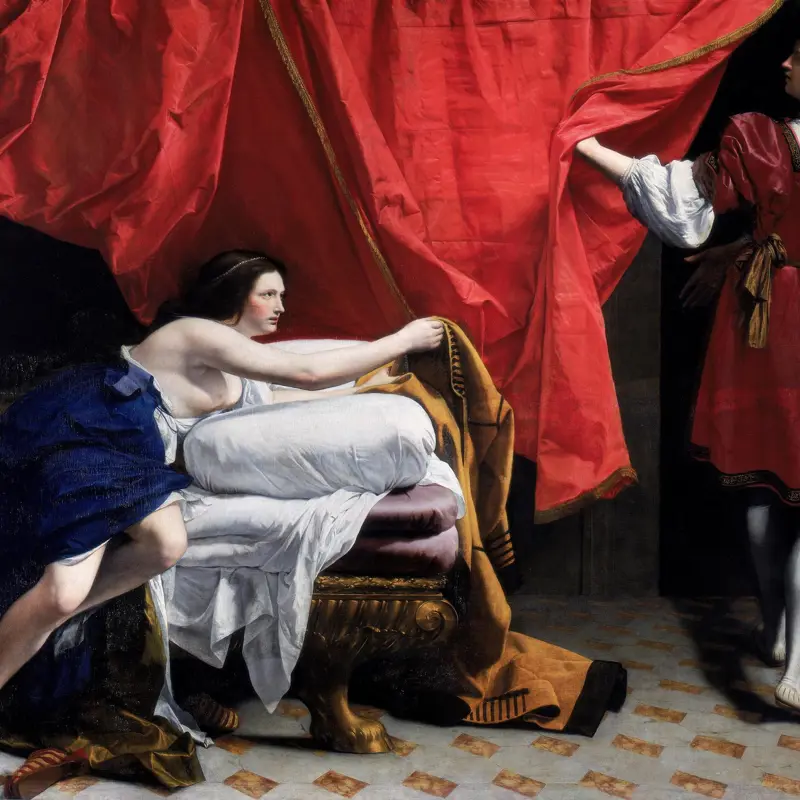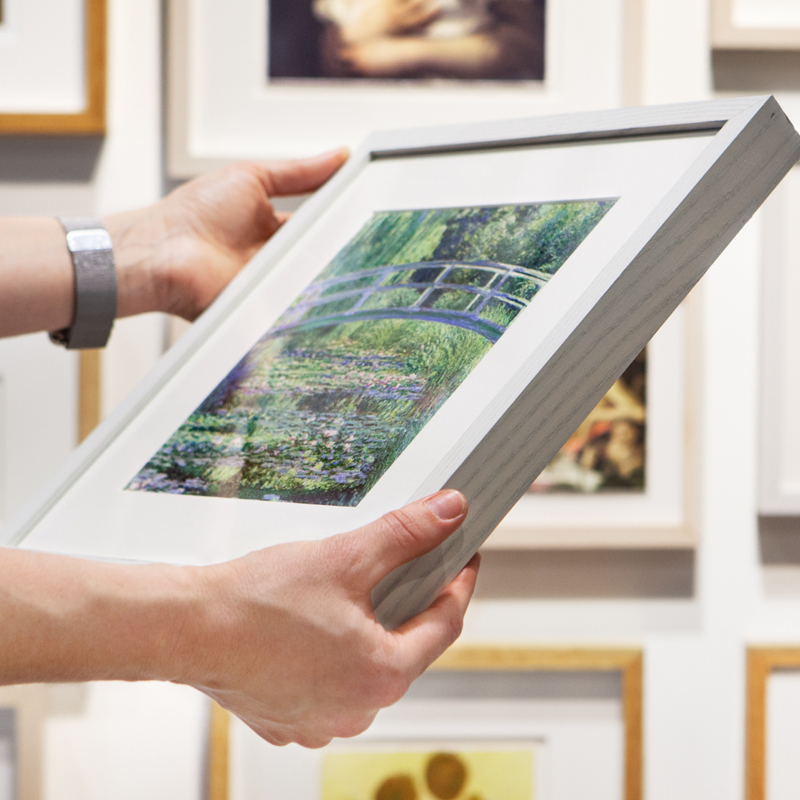Orazio Gentileschi, 'The Finding of Moses', early 1630s
About the work
Overview
In this vast canvas Orazio Gentileschi depicts the Old Testament story of the Finding of Moses (Exodus 2:2-10). When Pharaoh decreed that all newborn sons of Hebrews should be killed, the infant Moses was placed by his mother in a basket and hidden in bulrushes to ensure his safety.
Here, nine elegant female figures crowd around the basket at the heart of the composition. The woman in the magnificent yellow gown embellished with jewels is Pharaoh’s daughter. The diminutive figure kneeling respectfully at lower left is Moses’s sister Miriam, and beside her, dressed in red and white, is her mother.
The Finding of Moses was commissioned by Charles I of England for his wife, Queen Henrietta Maria, almost certainly to celebrate the birth of their son and heir, the future Charles II. It originally hung in the Queen’s House at Greenwich, on the banks of the River Thames. This location is reflected in the lush green landscape, which looks far more like England than Egypt where the story is set.
Audio description
Listen to an audio description of Orazio Gentileschi's 'The Finding of Moses'
Transcript
This is a description of 'The Finding of Moses' by Orazio Gentileschi. This huge landscape painting is about 2.5 metres high and 3 metres wide, painted in oils in the early 1630s. It hangs in a gold frame with small leaf-like details around the outer edge.
The canvas is almost completely filled with a group of nine, life-size women, gathered near a river. It’s a 17th century retelling of the biblical story which took place in Egypt. However, the lush green setting looks more like the English countryside. The women are all white Europeans, dressed in lavish gowns of silk and velvet in rich shades of red, gold, green, blue and purple, glistening and iridescent in the sunlight. The women have similar facial features: hazel eyes, rosy cheeks and lips. Their light-brown or dark-blonde hair is pinned up in twists and braids.
Behind them, the brown trunks and dark green foliage of trees contrasts with their colourful dresses. To the far right, puffy grey and white clouds animate the light blue sky, above gently rolling hills and the thin blue line of a river in the distance. In the foreground, there is brown earth and patchy grass beneath the women’s bare feet.
The woman in the middle of the group, is in gold, taller and more ornately dressed than the others. Her gown and hairband are trimmed with sapphires and pearls, and an attentive lady’s maid stands behind her, holding her bundled skirts above the ground.
At the front of the group, to the right, a woman in white is on one knee, presenting a woven basket up to the woman in gold. In contrast to the other figures, she wears a simple white cotton dress, perhaps an under-garment. One of her arms is not in its sleeve, as if she has dressed in a hurry, leaving the side of her breast and shoulder exposed. The soles of her feet are muddy.
The others eagerly lean in to see what the basket holds – a chubby baby boy nestled in a blanket! Two of the women gesture, as if to ask, ‘who is this? Where did he come from?’ and in answer, two others on the right point with outstretched arms into the distance, towards the river.
The woman in gold points down to the baby and looks to a woman on the far left, who is leaning forward, letting her red dress slip from her shoulder, as if ready to breastfeed the baby. This same woman gently touches the back of the girl kneeling in front of her, dressed in green, who holds out an arm towards the baby. Her kneeling pose mirrors the woman holding the basket, beautifully balancing the composition.
In the biblical story, when the Egyptian Pharaoh decreed that all newborn Israelite boys should be killed, Jochabed hid her son, Moses, in the reeds of the river Nile, hoping that he would be saved. While bathing in the river with her attendants, Pharaoh’s daughter discovers him. In this painting she is the woman in gold. She goes on to raise Moses as her own. Without revealing her true identity, Jochabed, the woman in red, acts as a wet nurse, allowing her some precious extra time with her son.
This version was commissioned by King Charles I and Queen Henrietta Maria, of Great Britain and Ireland, to celebrate the birth of their son – the future Charles II. So instead of the story being set in Ancient Egypt, Gentileschi has transported it to the Stuart Court, with the baby representing both Moses, the future leader of his people, and also the new royal heir. The painting would have originally hung in the Queen’s House in Greenwich, to the left-hand side of a large window, giving the impression that the women pointing into the distance were gesturing not to the Nile, but to the River Thames.
Key facts
Details
- Full title
- The Finding of Moses
- Artist
- Orazio Gentileschi
- Artist dates
- 1563 - 1639
- Date made
- Early 1630s
- Medium and support
- Oil on canvas
- Dimensions
- 257 × 301 cm
- Acquisition credit
- Bought with the support of the American Friends of the National Gallery, the National Gallery Trust, the National Heritage Memorial Fund, Art Fund (through the legacy of Sir Denis Mahon and with a contribution from the Wolfson Foundation), The Maurice Wohl Charitable Foundation, The Deborah Loeb Brice Foundation, The Capricorn Foundation, The Manny and Brigitta Davidson Charitable Foundation, Alejandro and Charlotte Santo Domingo, Beatrice Santo Domingo, The Wei Family and other donors, and through public appeal and bequests, 2020
- Inventory number
- NG6684
- Location
- Room 31
- Collection
- Main Collection
- Frame
- 19th-century English Frame
Provenance
Additional information
Text extracted from the National Gallery’s Annual Report, ‘The National Gallery: Review of the Year, April 2019 – March 2020’.
Exhibition history
-
2018Charles I: King and CollectorRoyal Academy of Arts27 January 2018 - 15 April 2018
-
2021The Director's Choice: Lizards, Fancy Feathered Hats and TrickeryThe National Gallery (London)5 May 2021 - 9999
-
2022Fruits of the Spirit: Art from the HeartThe National Gallery (London)November 2022 - 9999
Bibliography
-
2020National Gallery, The National Gallery: Review of the Year, April 2019 - March 2020, London 2020
-
2022S. Avery-Quash and A. Lepine (eds), Fruits of the Spirit: Art from the Heart, London 2022
About this record
If you know more about this work or have spotted an error, please contact us. Please note that exhibition histories are listed from 2009 onwards. Bibliographies may not be complete; more comprehensive information is available in the National Gallery Library.



